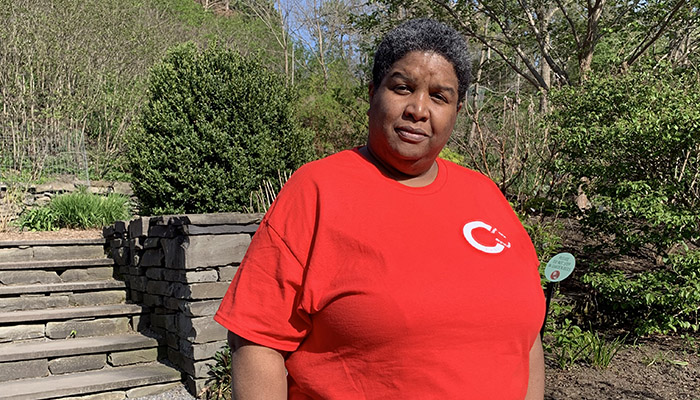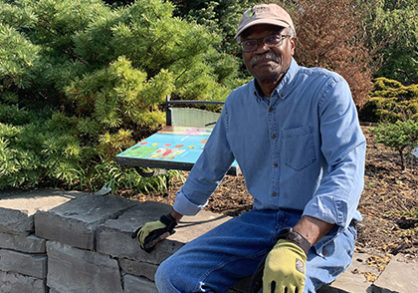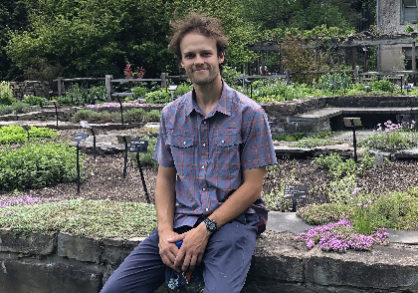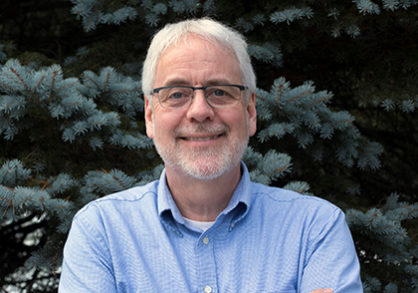
“When I came back to Cornell after getting my degree in landscape architecture practice here and going to work professionally for several years, I noticed a new building: the Nevin Welcome Center. When I saw that building, I just thought, ‘wow’. It blew me away. The whole presence of the Botanic gardens there, even with the parking lot, from a landscape architecture point of view, just really gives you a great sense of you’ve arrived. It was really well thought out and put together. And trust me, you’ll know bad design when you see it. But when you finally get to that area, with all the trees, the bioswale, and the sweet smell, it just feels right.
I absolutely love working with the Botanic Gardens. It’s a huge resource and asset to the university. I hope people and students appreciate and understand it. There are very few places on campus where you can go and be in the quiet and really simply enjoy the quiet. There’s nature all the way around, sure, but there’s something to be said about walking around and seeing the beauty and being able to read things about it as well. When I go to the Botanic gardens, I just need a moment to clear my head and to just be in nature. There’s something about it there that is just so inviting.

Over the past year, I’ve been on a panel working with the Botanic Gardens and some students on an exhibit showcasing plants significant to African Americans. Over the course of the planning process, I had a lot of students come to me for answers, but we were really trying to treat it like a live client, because it was. What the students had to learn through this was that of course, their future jobs as landscape architects was going to be with a professional degree. So all of them would be coming out working professionally; they’re going to have a client and need to get used to working with them and meeting their needs. They can’t be asking me for absolutely everything they need. So the students got that practice from working with the Botanic Gardens.
In my own classes teaching at Cornell, I have used the Botanic Gardens a lot. There are terms in landscape architecture called design intervention and design thinking: considering all aspects of some piece of land before we design it to be useful. For instance, you may look at sun and shade patterns, where the trees are, the topography pattern, etc. Is there water on the site? Who are the current users of the place? What ages are they and what are their professions? Are they able-bodied or not? You want to be thinking, ‘how can I design this place to be well-used and well-liked for everyone?’.
For instance, we had students consider Beebe lake beach. That was a design intervention area example for us where we took students and thought, how can we make this more accessible? Can we adjust the flow of the water to try minimize the correction efforts that go on after each winter along the path? Another area we tested was the bridge area behind the Martin Y. Tang Welcome Center, which is not something that is too accessible to get down, for example for people with wheelchairs. We even considered designing another parking lot there. The upper-level grad students with this assignment really took all these thoughts and ran with them well to create actual designs, and it was really cool to witness. You see, all of this work using the Cornell Botanic Gardens areas really helps the students to envision things better and to be thinking, ‘what else can be done with this already beautiful space?’. I think it would be fun for my future classes to keep going to the Botanic Gardens and see what ideas we have.”

Valerie Aymer, an associate professor of practice in the department of landscape architecture in CALS and a Cornell Botanic Gardens Faculty Fellow, is passionate about pointing out and creating good design. She has used the Botanic Gardens several times in her classes where her expertise and keen eye for appreciation work together to use our sites for teaching students about the real experiences that working as a landscape architect can bring.
Gregory’s Story!
Professor Emeritus Gregory Page shares how Cornell Botanic Gardens was integral to teaching his art classes.
Gavin’s Story!
Gavin Ratliff, a current senior studying landscape architecture, tells us how the design of the Cornell Botanic Gardens and his own passions work together to create enriching experiences.
Kevin’s Story!
Student and Public Engagement Coordinator Kevin Moss tells a heartwarming story stemming from his love for a past tree in the Botanic Gardens.


